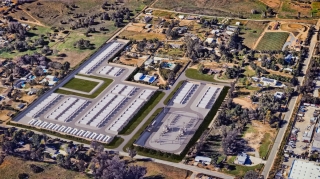 By Michael Howard
By Michael HowardPhoto by Michael Howard: Former Sempra executive Joseph Rowley is flanked by fellow Escondido residents against a proposed clean energy battery energy storage system in Escondido.
May 14, 2024 (Escondido) – The developer of a proposed battery energy storage system (BESS) slated to be built just over a quarter mile from Palomar Hospital in Escondido held its last in a series of three workshops last week at the San Marcos Community Center. The workshop was geared toward addressing the concerns of local citizens who have organized opposition to the project by gathering upwards of 2,700 signatures against the project.
The batteries are meant to bridge the energy gap between traditional energy sources provided by San Diego Gas and Electric (SDGE) and the spike of usage during peak times when historic “brown” or blackouts are ordered to mitigate capacity issues.
But residents nearby say the project poses health and safety risks. Ashley Robertson Bedard, a vocal opponent of the project who has attended all three workshops says it's a disaster waiting to happen.
"Battery energy storage systems are known to cause thermal runaway, leading to fires and toxic fumes," Bedard stated. "With over 40 million battery cells planned for this facility, the potential for disaster is enormous,” she asserts.
The developer of the project, AES, says fire and safety precautions are at the forefront of their design and provided a detailed look at the fire protection strategies they plan to deploy in previous workshops. In its presentation to community residents in March, AES Development Manager Max Guarniere explained new fire prevention codes provide further protection.
“The piece that is new is gas detection and explosion prevention,” he explained. “So, when a battery cell gets above a certain operating threshold, it's usually around 220 degrees or more, they will start to release gas and that is an indication that something could happen if you don't stop the operation. And so with early gas detection, we're now able to isolate the system, take a closer look before an actual event occurs.”
In its April workshop the developer held a panel discussion with several fire and risk engineering experts who discussed and outlined several layers of protection proposed that meet local, state and federal standards and certification requirements. The protections listed include an electrical diagnostic and isolation system, gas detection and power block isolation, smoke and sensor-triggered fire suppression and isolating fires within individual battery containers.
Globally, BESS fires are on the radar. The Electric Power Research Institute (EPRI), an independent, non-profit energy research, development, and deployment organization with subsidiaries in Europe, the Middle East and Africa, has developed and maintained a battery energy storage system failure event database. According to the database, there have been 72 BESS failures globally since 2018.
One such event listed on the EPRI database is the Valley Center Terra-Gen battery storage fire in April of 2022 where a single battery cell approximately the size of a DVD case caught fire and the fire suppression system worked according to design, as reported by the Valley Roadrunner.
 Photo: An artist rendering of a proposed 22.5 acre battery energy storage system facility located a quarter mile from Palomar Hospital in Escondido. Photo by Michael Howard.
Photo: An artist rendering of a proposed 22.5 acre battery energy storage system facility located a quarter mile from Palomar Hospital in Escondido. Photo by Michael Howard.But not everyone is convinced. In last Tuesday's workshop, former Sempra Vice President of Project Development Joseph Rowley came out against the project.
“I have many years of experience in selecting sites for projects like this for large scale power projects, that's basically what I did my entire career, and this project, while it does make sense from an electrical interconnection standpoint, it makes no sense at all with regard to the surroundings of the site itself,” he asserted.
According to Rowley, the danger is both the difficulty in putting out battery fires, as well as the toxic gasses that propagate from the fire.
“There is no way to suppress that type of fire,” he said of lithium-ion thermal runaway battery fires, “because it’s more akin to say, rocket fuel than to say fuel oil. Whereas rocket fuel has its oxidant inside the fuel – it doesn’t need any oxygen to burn – a lithium-ion battery is the same,” he explained.
And with the proximity of residents and the hospital nearby, toxic gasses are an issue too, Rowley says. “The fire puts out things like hydrofluoric acid and hydrogen cyanide. I mean, these are extremely toxic gasses that come up with this type of fire,” he proclaimed.
But, with the fire protection systems that the developer has proposed, and the testing required to achieve the necessary certifications, AES is confident that any fire on the site would not breach the boundaries of the facility.
“We are confident based on the different analysis that we've done today that if there were to be a fire, it wouldn't spread, certainly from the container it's in, but also it wouldn't get past the road that's in between the container and the wall itself,” Corinne Bonine of AES maintains.
Speaking at the May 7 event, Bonine says she knows there’s a lot of opposition to the project. “There’s a lot of emotions here,” she admits, “we want to put together a project that will look at impacts maybe we’re not thinking of,” she affirmed.
According to Rowley, the problem isn’t really the developer’s intentions. More so, it’s the newness of technology.
“Regulations have not caught up with the technology – this technology is changing extremely quickly,” he said. “There’s no consensus on how to best suppress fires at these types of facilities. You have proposals that range from large amounts of water to various chemicals and everything in between,” Rowley professes.
“So, yeah, they have solutions, but it’s a moving target,” he adds.
SOURCES
AES. (2024, April 17). Workshop 2: Battery Energy Storage Safety. Community Workshop Series.
Bedard, A. R. (2024, March 21). Concerned Resident [Personal communication].
Bonine, C. (2024, May 7). Director, Permitting—Wind, Permitting and Real Estate—West at AES [Personal communication].
Corinne Lytle Bonine | LinkedIn. (n.d.). Retrieved May 12, 2024, from https://www.linkedin.com/in/corinne-lytle-bonine-2056498/
Electric Power Research Institute. (n.d.). BESS Failure Incident Database. BESS Failure Incident Database. https://storagewiki.epri.com/index.php/BESS_Failure_Event_Database
Google Maps. (n.d.). Google Maps. Google Maps. Retrieved May 12, 2024, from https://www.google.com/maps/@33.1230793,-117.129239,1287m/data=!3m1!1e3?entry=ttu
Howard, M. (2023, April 21). Residents tell concerns about proposed battery storage facility—Escondido Times-Advocate. Escondido Times-Advocate - The Hometown Newspaper of Escondido, California. https://www.times-advocate.com/articles/residents-tell-concerns-about-pr...
Howard, M. (2024, March 28). Escondido Times-Advocate—2024-03-28. https://www.times-advocate.com/pageview/viewer/2024-03-28
LinkedIn. (n.d.). Joseph Rowley | LinkedIn. Retrieved May 12, 2024, from https://www.linkedin.com/in/joseph-rowley-51856158/
Rowley, J. (2024, May 7). Retired, Vice President Project Development, Sempra U.S. Gas & Power [Personal communication].










Comments
North Johnson Energy Center
Nice to see SDG&E being proactive on a renewable energy grid
Battery storage sites are a MUST if we ever want to move to a 100% clean and renewable energy grid. This story focuses on the opposition to the project, but doesn't skip SDG&E's logic. Good story, thanks for covering the community resistance, that's certainly a story, and will hopefully ensure good safeguards are included if the project continues, like Michael Howard mentions the new fire prevention measures that worked in a similar situation, and the rest of SDG&E's reasoning behind the project. So often reporters get caught up in covering one side or the other. The coverage to the opposition is generous, but also covers the logic behind the project.
I hope we can get to 100% clean and renewable energy and it sounds from this story like the community's concerns are valid but that technology exists to make these sorts of projects feasible, and I think that's great that Mr. Howard included: One such event listed on the EPRI database is the Valley Center Terra-Gen battery storage fire in April of 2022 where a single battery cell approximately the size of a DVD case caught fire and the fire suppression system worked according to design, as reported by the Valley Roadrunner.
Thanks for not neglecting SDG&E's version of events. They're such a popular villain yet are so highly regulated and have to do sooo much that the government tells them to do, when it comes to improving energy efficiency, when it comes to clean and renewable energy, EVERYTHING, they just do what California regulators and legislators tell them to do, yet everyone still loves to hate them. I for one appreciate a reliable energy grid, and think it's great they're so proactive on a clean and renewable, yet RELIABLE, power grid. These sorts of projects are a must, and their time of day billing encourages projects like these to move forward that they don't necessarily have to initiate every single one of them.
battery storage fire
FIRE AT OTAY BATTERY STORAGE FACILITY PROMPTS EVACUATION WARNINGS, SHELTER-IN-PLACE ORDER FOR DONOVAN PRISON | East County Magazine